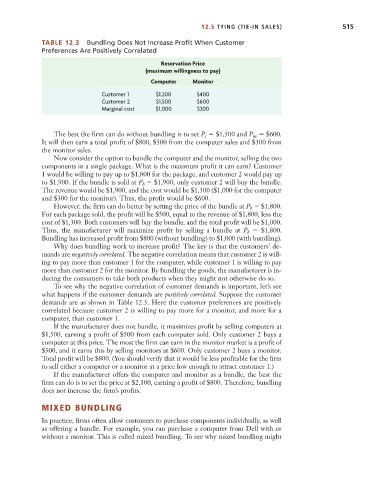Page 541 - Microeconomics, Fourth Edition
P. 541
c12capturingsurplus.qxd 7/22/10 10:41 AM Page 515
12.5 TYING (TIE-IN SALES) 515
TABLE 12.3 Bundling Does Not Increase Profit When Customer
Preferences Are Positively Correlated
Reservation Price
(maximum willingness to pay)
Computer Monitor
Customer 1 $1,200 $400
Customer 2 $1,500 $600
Marginal cost $1,000 $300
The best the firm can do without bundling is to set P $1,500 and P $600.
c
m
It will then earn a total profit of $800, $500 from the computer sales and $300 from
the monitor sales.
Now consider the option to bundle the computer and the monitor, selling the two
components in a single package. What is the maximum profit it can earn? Customer
1 would be willing to pay up to $1,800 for the package, and customer 2 would pay up
to $1,900. If the bundle is sold at P $1,900, only customer 2 will buy the bundle.
b
The revenue would be $1,900, and the cost would be $1,300 ($1,000 for the computer
and $300 for the monitor). Thus, the profit would be $600.
However, the firm can do better by setting the price of the bundle at P $1,800.
b
For each package sold, the profit will be $500, equal to the revenue of $1,800, less the
cost of $1,300. Both customers will buy the bundle, and the total profit will be $1,000.
Thus, the manufacturer will maximize profit by selling a bundle at P $1,800.
b
Bundling has increased profit from $800 (without bundling) to $1,000 (with bundling).
Why does bundling work to increase profit? The key is that the customers’ de-
mands are negatively correlated. The negative correlation means that customer 2 is will-
ing to pay more than customer 1 for the computer, while customer 1 is willing to pay
more than customer 2 for the monitor. By bundling the goods, the manufacturer is in-
ducing the consumers to take both products when they might not otherwise do so.
To see why the negative correlation of customer demands is important, let’s see
what happens if the customer demands are positively correlated. Suppose the customer
demands are as shown in Table 12.3. Here the customer preferences are positively
correlated because customer 2 is willing to pay more for a monitor, and more for a
computer, than customer 1.
If the manufacturer does not bundle, it maximizes profit by selling computers at
$1,500, earning a profit of $500 from each computer sold. Only customer 2 buys a
computer at this price. The most the firm can earn in the monitor market is a profit of
$300, and it earns this by selling monitors at $600. Only customer 2 buys a monitor.
Total profit will be $800. (You should verify that it would be less profitable for the firm
to sell either a computer or a monitor at a price low enough to attract customer 1.)
If the manufacturer offers the computer and monitor as a bundle, the best the
firm can do is to set the price at $2,100, earning a profit of $800. Therefore, bundling
does not increase the firm’s profits.
MIXED BUNDLING
In practice, firms often allow customers to purchase components individually, as well
as offering a bundle. For example, you can purchase a computer from Dell with or
without a monitor. This is called mixed bundling. To see why mixed bundling might

